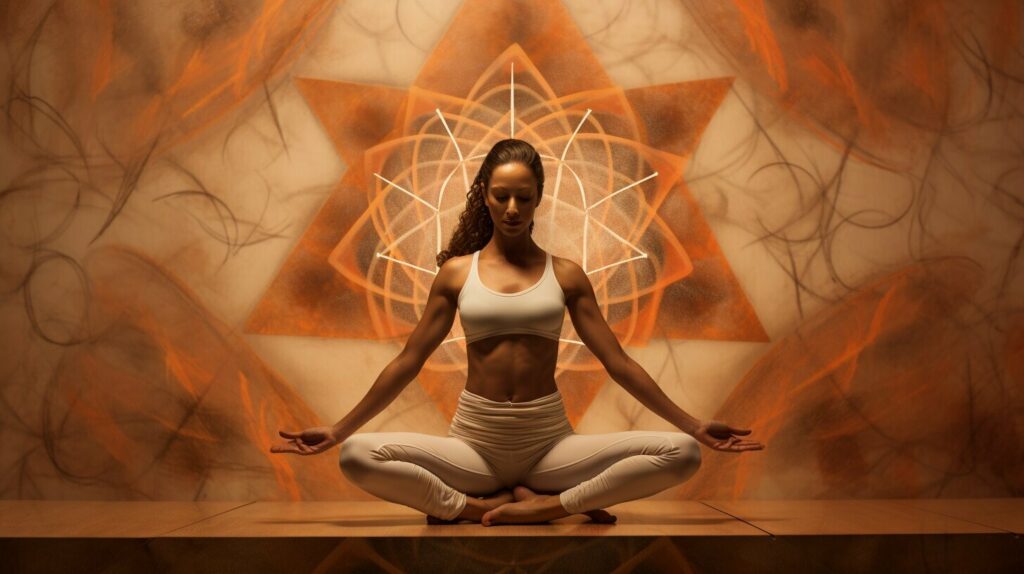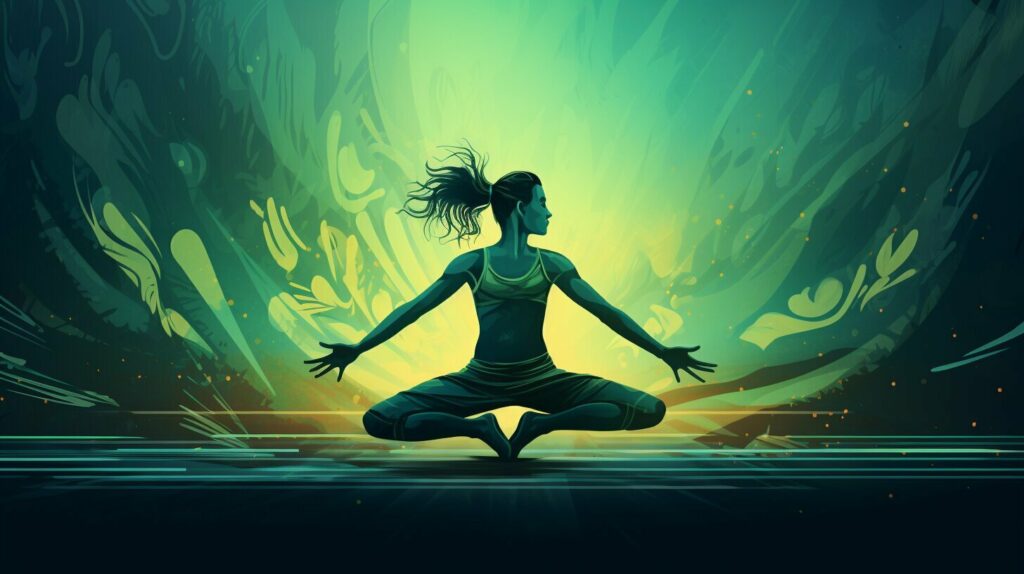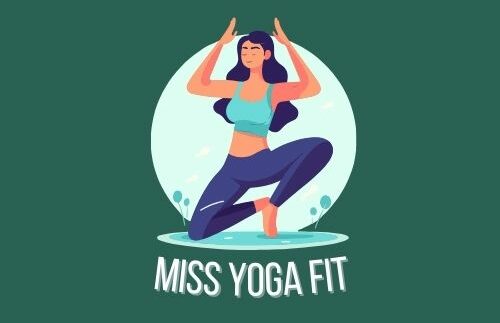In this section, we will delve into the fundamentals of Ashtanga Yoga, a dynamic and intensive yoga practice that originated in India.
Ashtanga Yoga is a physically demanding form of yoga that involves flowing through a series of postures, or asanas, in a specific sequence. This practice focuses on connecting breath and movement, creating a moving meditation that cultivates strength, flexibility, and stamina.

What is Ashtanga Yoga
Ashtanga Yoga is suitable for practitioners of all levels, from beginners to advanced yogis. It offers a transformative and holistic approach to physical, mental, and spiritual well-being, encouraging practitioners to cultivate mindfulness, self-awareness, and inner peace.
Are you curious about Ashtanga Yoga? Whether you’re new to yoga or an experienced practitioner, this dynamic practice offers a unique way to enhance your mind-body connection. Read on to discover the origins, principles, benefits, and philosophy of Ashtanga Yoga.
Key Takeaways:
- Ashtanga Yoga is a dynamic and intensive form of yoga originating in India.
- This practice involves flowing through a series of postures in a specific sequence, connecting breath and movement.
- Ashtanga Yoga offers a transformative and holistic approach to physical, mental, and spiritual well-being.
- Practitioners of all levels can benefit from Ashtanga Yoga, which encourages mindfulness, self-awareness, and inner peace.
- Stay tuned to discover the origins, principles, benefits, and philosophy of Ashtanga Yoga.
Table of Contents
Origins of Ashtanga Yoga
In this section, we will uncover the fascinating origins of Ashtanga Yoga and its deep-rooted connection to the renowned yoga teacher Sri K. Pattabhi Jois. Ashtanga Yoga is a dynamic form of yoga that has its roots in ancient India. The practice was passed down through generations before it was brought to the modern world by Jois.
Jois was born on July 26, 1915, in the town of Kowshika, in the South Indian state of Karnataka. He was a student of the revered yoga guru T. Krishnamacharya, who is widely considered the father of modern yoga. Jois first learned Ashtanga Yoga from Krishnamacharya when he was just 12 years old.
In the 1930s, Jois established the Ashtanga Yoga Research Institute in Mysore, India, where he taught Ashtanga Yoga to students from all over the world. He continued to teach until his passing in 2009, at the age of 94. Today, Jois is remembered as one of the most influential yoga teachers of the modern era.
Nowadays, Ashtanga Yoga has become a popular and widely practiced form of yoga, with studios and practitioners all over the world. It continues to evolve and adapt, but its roots remain firmly planted in the teachings of Sri K. Pattabhi Jois and the ancient traditions of yoga.
Ashtanga Yoga has evolved over time, but the core principles and sequence remain unchanged. Jois believed that the practice of Ashtanga Yoga should be available to everyone, regardless of their background or experience level. He famously said, “Ashtanga Yoga is for 99% practice, 1% theory.“

Principles of Ashtanga Yoga
In Ashtanga Yoga, the practice is based on eight limbs, or principles, that guide the practitioner towards a holistic approach to physical, mental, and spiritual well-being. These principles were first outlined in the Yoga Sutras of Patanjali, a text written over 2,000 years ago.
The eight limbs of Ashtanga Yoga are:
- Yama – ethical disciplines, including non-violence, truthfulness, and non-stealing
- Niyama – personal observances, including cleanliness, contentment, and self-discipline
- Asana – physical postures, which prepare the body for meditation and relaxation
- Pranayama – breath control, which helps to regulate energy and enhance focus
- Pratyahara – withdrawal of the senses, allowing the practitioner to turn inward and focus on the mind and body
- Dharana – concentration, the ability to focus the mind on one object or thought
- Dhyana – meditation, cultivating a calm and tranquil mind
- Samadhi – enlightenment, the ultimate goal of the practice where the practitioner experiences a state of pure awareness and consciousness
Each of these eight limbs builds upon the previous one, creating a strong foundation for the practice of Ashtanga Yoga. By incorporating all eight limbs into their practice, practitioners can develop a deeper understanding of themselves and their connection to the world around them.
It’s important to note that the practice of Ashtanga Yoga is flexible and adaptable to each individual’s needs and abilities. Practitioners can modify their practice to suit their physical limitations or health concerns, making it a practice that is accessible to people of all levels and backgrounds.
The Ashtanga Yoga Sequence
The Ashtanga Yoga sequence is a structured set of postures performed in a specific order, known as the primary series and the advanced series. The primary series, also known as Yoga Chikitsa, focuses on detoxifying the body and building strength, while the advanced series, also known as Nadi Shodhana, challenges the practitioner’s physical and mental abilities.
The primary series consists of 75 postures that are performed in a specific order, each with its unique benefits. The sequence begins with sun salutations, followed by a series of standing postures, seated postures, and a closing sequence that includes backbends, inversions, and a final relaxation posture.
The advanced series is a continuation of the primary series and is only recommended for experienced practitioners who have mastered the primary series. This series consists of more challenging postures that require greater flexibility, strength, and endurance.
It’s important to note that the Ashtanga Yoga sequence is not a one-size-fits-all practice and should be adapted to each individual’s physical and mental abilities. As with any yoga practice, it’s essential to listen to your body and modify the postures if necessary.
Benefits of Ashtanga Yoga
Ashtanga Yoga offers a multitude of benefits for both physical and mental health. The dynamic practice of Ashtanga Yoga focuses on synchronizing breath with movement, creating a moving meditation that cultivates mindfulness, concentration, and inner peace.
Physically, Ashtanga Yoga can improve flexibility, strength, and endurance. The practice involves a series of postures that promote a healthy spine, improve circulation, and stimulate the digestive system. The primary series of Ashtanga Yoga, also known as Yoga Chikitsa, is particularly beneficial for building a strong foundation in the practice and developing physical awareness.

| Physical Benefits: | Mental Benefits: |
|---|---|
|
|
Ashtanga Yoga can also be an effective tool for managing mental health. The practice emphasizes the connection between body, mind, and breath, providing practitioners with a holistic approach to stress reduction and overall well-being. Regular practice can improve mood, reduce symptoms of depression and anxiety, and enhance emotional resilience.
Whether you are looking to improve physical fitness, reduce stress, or deepen your spiritual practice, Ashtanga Yoga offers a dynamic and transformative approach to yoga. By integrating movement, breath, and meditation, Ashtanga Yoga can help you achieve optimal health and wellness in body, mind, and spirit.
Ashtanga Yoga Philosophy
In Ashtanga Yoga, the physical practice is just one aspect of a holistic approach to well-being. The philosophical underpinnings of this practice are rooted in the teachings of Patanjali’s Yoga Sutras, a text that outlines the eight limbs of yoga.
The first limb, yama, outlines ethical principles for living in the world and includes concepts such as non-violence, truthfulness, and non-attachment. The second limb, niyama, focuses on self-discipline and personal observances, such as cleanliness, contentment, and self-study. The third limb is asana, the physical postures, while the fourth is pranayama, the control of the breath.
The fifth limb, pratyahara, involves withdrawing the senses from external distractions, while the sixth limb, dharana, is the practice of concentration. The seventh limb, dhyana, is meditation, and the eighth and final limb is samadhi, a state of pure consciousness and spiritual realization.
This eight-limbed path provides a guide for living a meaningful and purposeful life, both on and off the mat. By incorporating these principles into their practice, Ashtanga Yogis strive to cultivate a deeper awareness of themselves and the world around them, leading to a more fulfilling and fulfilling life.

“When the mind becomes clear and serene, the Self reflects without disfigurement, and we realize the Truth in its own original nature.” – Patanjali’s Yoga Sutras
Ashtanga Yoga and Meditation
Meditation is an integral part of Ashtanga Yoga, encouraging practitioners to cultivate mindfulness, focus, and inner peace. The practice of Ashtanga Yoga involves a series of postures that are performed in a specific order, with each pose flowing seamlessly into the next.
This dynamic and intensive practice requires a high level of concentration and mental focus, making it an ideal platform for exploring various meditation techniques.
One of the key components of Ashtanga Yoga meditation is the use of controlled breathing, known as Ujjayi Pranayama. This technique involves breathing in through the nose, while constricting the back of the throat, creating a gentle hissing sound. This rhythmic breathing helps to calm the mind, while also providing a physical anchor for meditative focus.
Another important aspect of Ashtanga Yoga meditation is the use of Dristi, or focal points. These are specific points where the gaze is directed during each pose, such as the tip of the nose, the fingertips, or the horizon. By focusing on a particular point, practitioners can improve their concentration and mental clarity, helping to deepen their meditative practice.
The Benefits of Mindfulness Practice
Through regular practice of Ashtanga Yoga meditation, practitioners can experience a wide range of physical and mental benefits. Mindfulness practices have been shown to improve stress management, enhance mental clarity, and boost overall well-being. Studies have also suggested that regular meditation can help to improve immune function, reduce inflammation, and even slow the aging process.
Ashtanga Yoga provides a unique platform for exploring the benefits of mindfulness, offering a challenging and dynamic practice that encourages practitioners to cultivate mental focus, clarity, and inner peace.

Whether you are an experienced yogi or just starting your yoga journey, Ashtanga Yoga meditation can offer a powerful tool for enhancing your physical and mental well-being. By incorporating various meditation techniques into your practice, you can unlock a deeper level of awareness and transform your yoga practice into a holistic approach to health and wellness.
Ashtanga Yoga for All Levels
Ashtanga Yoga is known for its dynamic and intensive practice, but it’s important to note that this style of yoga is accessible for practitioners of all levels. While the traditional sequence may seem daunting, modifications and variations can be incorporated to make the practice more approachable for beginners.
One of the most common modifications for beginners is to shorten the practice by performing only a portion of the full sequence. For example, a practitioner may start with the standing postures and gradually add additional postures as they become more comfortable with the practice.
Another modification is to use props, such as blocks or straps, to help with certain postures that may require more flexibility. In addition, teachers can offer alternative variations of certain postures to accommodate different levels of flexibility and strength.
It’s important to remember that Ashtanga Yoga is not a one-size-fits-all practice. Each practitioner’s journey is unique, and modifications should be made to honor and work with individual strengths and limitations.
Beginner-Friendly Ashtanga Yoga Resources
For beginners looking to explore the world of Ashtanga Yoga, there are many resources available to help make this practice more accessible:
- Ashtanga Yoga: The Practice Manual by David Swenson is a comprehensive guide to the Ashtanga Yoga practice. It includes modifications and variations for practitioners of all levels.
- Ashtanga Yoga for Beginners is a YouTube series that offers a beginner-friendly introduction to the practice. It includes detailed instructions for each posture, as well as modifications for beginners.
- Ashtanga Yoga: The power of Ashtanga Yoga by Kino MacGregor is a Book that includes modified versions of the full Ashtanga Yoga sequence. It’s a great resource for beginners looking to start with a shorter practice.
By incorporating modifications and using beginner-friendly resources, practitioners of all levels can enjoy and benefit from the dynamic practice of Ashtanga Yoga.
Alternatives to Ashtanga?
If you feel that this particular yoga style may not align with your current stage in your yoga journey, allow me to introduce you to some alternative yoga styles that I believe will better suit your yoga goals. I encourage you to explore them – they might be just what you’re looking for!

Conclusion
Ashtanga Yoga is a dynamic and intensive yoga practice with a rich history and philosophy. In this article, we have explored the fundamentals of Ashtanga Yoga, including its origins, principles, sequence, benefits, philosophy, and accessibility.
While the practice can be physically and mentally challenging, it offers numerous benefits, including improved physical strength, flexibility, and endurance, as well as stress reduction and mental clarity.
Moreover, the Ashtanga Yoga philosophy and meditation techniques can guide practitioners towards a more mindful and purposeful life both on and off the mat.
Whether you are a seasoned yogi or just starting your yoga journey, Ashtanga Yoga is a practice worth exploring. By incorporating modifications and variations, it can be made accessible and beginner-friendly.
Join us in embracing the transformative power of Ashtanga Yoga and start your journey towards physical, mental, and spiritual well-being today.
FAQ
What is Ashtanga Yoga?
Ashtanga Yoga is a dynamic and intensive practice that originated in India. It is a style of yoga that focuses on a structured sequence of postures performed in a specific order.
What are the key elements of Ashtanga Yoga?
The key elements of Ashtanga Yoga include synchronized breath and movement, intense physical postures, and a set sequence of postures that progressively builds strength and flexibility.
Who founded Ashtanga Yoga?
Ashtanga Yoga was passed down through generations by Sri K. Pattabhi Jois, a renowned yoga teacher from India. He refined and popularized this style of yoga, making it accessible to practitioners worldwide.
What are the eight limbs of yoga in Ashtanga Yoga?
The eight limbs of yoga in Ashtanga Yoga are Yama (ethical principles), Niyama (self-discipline), Asana (physical postures), Pranayama (breath control), Pratyahara (withdrawal of senses), Dharana (concentration), Dhyana (meditation), and Samadhi (blissful state of consciousness).
What is the primary series in Ashtanga Yoga?
The primary series, also known as Yoga Chikitsa, is the foundational sequence of Ashtanga Yoga. It focuses on detoxification, purification, and alignment of the physical body.
Are there advanced series in Ashtanga Yoga?
Yes, beyond the primary series, there are advanced series in Ashtanga Yoga. These series, known as Nadi Shodhana, further challenge practitioners’ strength, flexibility, and mental focus.
What are the benefits of practicing Ashtanga Yoga?
Practicing Ashtanga Yoga can improve physical strength, flexibility, and endurance. It can also enhance mental clarity, reduce stress, and promote overall well-being.
What is the philosophy behind Ashtanga Yoga?
The philosophy behind Ashtanga Yoga draws from Patanjali’s Yoga Sutras and emphasizes a holistic approach to life. It guides practitioners to cultivate self-discipline, mindfulness, and a sense of inner peace.
How does Ashtanga Yoga incorporate meditation?
Ashtanga Yoga integrates meditation as an integral part of the practice. Through various meditation techniques, practitioners cultivate mindfulness, focus, and inner peace.
Is Ashtanga Yoga accessible for all levels?
Yes, Ashtanga Yoga can be modified and adapted to accommodate practitioners of all levels. It offers variations and modifications that make the practice beginner-friendly while still providing challenges for seasoned practitioners.
Magda Felcio, a certified Vinyasa Flow Yoga teacher in Brazil, is deeply passionate about the grace and transformation this practice offers. With a commitment to empowering her students, she creates harmonious and flowing sequences that focus on alignment and mindfulness.

